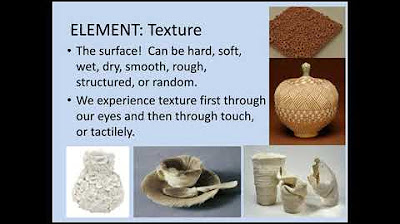Elements of Art: Line | KQED Arts
Summary
TLDRThis video script explores the significance of line as a fundamental element of art, alongside shape, color, texture, form, value, and space. It delves into how artists like Jean-Michel Basquiat and David Hockney utilize distinct line qualities to convey their style and emotions in self-portraits. The script encourages viewers to consider the lines in art, prompting them to analyze and interpret the messages artists intend to communicate through their unique line usage.
Takeaways
- 🎨 Each of the self-portraits featured is by a well-known artist, highlighting the importance of understanding art through its elements.
- 📏 Line is one of the seven elements of art, alongside shape, color, texture, form, value, and space, and is crucial for analyzing and interpreting art.
- 🚶♂️ Line represents the path created by movement, and in visual arts, it's created through drawing, painting, or shaping materials.
- 📸 Photographers and filmmakers also use lines by angling their cameras and composing their shots, emphasizing the universality of line in visual storytelling.
- 🕺 Lines can vary in direction (horizontal, vertical, diagonal), shape (straight, curved, freeform), and appearance (thick, thin, light, dark).
- 🔍 Describing lines can involve various qualities such as dashed, dotted, rough, smooth, zigzag, or implied, adding depth to the analysis of art.
- 👤 Jean-Michel Basquiat's self-portrait uses bold, jagged, and messy lines, suggesting a unique style and evoking certain emotions or thoughts.
- 🤔 David Hockney's self-portrait features faint, seemingly unfinished lines, which might suggest a different mood or artistic intention compared to Basquiat's.
- 🤷♀️ The choice of lines in a self-portrait is a personal decision that communicates specific messages to the viewer about the artist's identity.
- 👀 When observing art, paying attention to the types of lines used can enhance one's interpretation and connection to the artwork.
Q & A
What are the seven elements of art mentioned in the script?
-The seven elements of art mentioned are line, shape, color, texture, form, value, and space.
How is a line defined in the context of visual arts?
-In visual arts, a line is defined as the path created when an object moves from one point to another, and it can be made by drawing or painting marks on a surface, or by bending and shaping materials.
What are some ways lines can be categorized in art?
-Lines can be categorized as horizontal, vertical, or diagonal; straight, curved, or freeform; and they can vary in thickness, darkness, and style such as dashed, dotted, rough, smooth, or zigzag.
How do photographers and filmmakers create lines in their work?
-Photographers and filmmakers create lines by choosing how to angle their cameras and how to compose their shots.
What is the significance of an artist's unique way of making lines?
-An artist's unique way of making lines is significant as it is one of the ways they express their individual style.
How would you describe the lines in Jean-Michel Basquiat's self-portrait as mentioned in the script?
-The lines in Jean-Michel Basquiat's self-portrait are described as bold, jagged, and almost messy at times.
What might be the reason behind Basquiat's choice of line style in his self-portrait?
-Basquiat's choice of line style might be to represent his energetic and raw artistic expression, which is a reflection of his unique style and the emotions he wanted to convey.
How does David Hockney's use of line in his self-portrait differ from Basquiat's?
-David Hockney's self-portrait features faint, seemingly unfinished lines, suggesting a softer, more subtle approach to line work compared to Basquiat's bold and jagged lines.
What emotions or thoughts might Hockney's lines in his self-portrait evoke?
-Hockney's lines might evoke a sense of contemplation, gentleness, or perhaps a feeling of incompleteness or ongoing exploration.
If you were to draw a self-portrait, what kind of lines would you choose and why?
-The choice of lines in a self-portrait would depend on the emotions, personality traits, and style the artist wishes to express. For example, one might choose bold lines to represent confidence or delicate lines to convey sensitivity.
How can observing the lines in a piece of art enhance your interpretation of it?
-Observing the lines in a piece of art can enhance interpretation by providing insight into the artist's style, the mood they intend to convey, and the visual dynamics of the artwork.
Outlines

このセクションは有料ユーザー限定です。 アクセスするには、アップグレードをお願いします。
今すぐアップグレードMindmap

このセクションは有料ユーザー限定です。 アクセスするには、アップグレードをお願いします。
今すぐアップグレードKeywords

このセクションは有料ユーザー限定です。 アクセスするには、アップグレードをお願いします。
今すぐアップグレードHighlights

このセクションは有料ユーザー限定です。 アクセスするには、アップグレードをお願いします。
今すぐアップグレードTranscripts

このセクションは有料ユーザー限定です。 アクセスするには、アップグレードをお願いします。
今すぐアップグレード関連動画をさらに表示

The 7 Elements of Art Explained: A Fun and Easy Guide for Kids! 🎨

Elements of Art

Elements and Principles 3D Art - Google Slides

Paintings in CHINA, Japan and Korea | Lesson 1 | ARTS 8 | Weeks 1-3 | Quarter 2 | MELC Based

Elements of Art

Elements & Principles of Art & Design #Elements #Principles #ArtEduc #Learn #VisualArt #Artistry
5.0 / 5 (0 votes)
